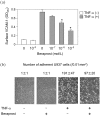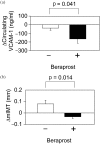Vascular endothelium as a target of beraprost sodium and fenofibrate for antiatherosclerotic therapy in type 2 diabetes mellitus
- PMID: 17319106
- PMCID: PMC1993948
Vascular endothelium as a target of beraprost sodium and fenofibrate for antiatherosclerotic therapy in type 2 diabetes mellitus
Abstract
Diabetes mellitus is an important risk factor for cardiovascular morbidity and mortality. The metabolic abnormalities caused by diabetes mellitus induce vascular endothelial dysfunction that predisposes patients with diabetes mellitus to atherosclerosis. Two mega clinical trials showed that intensive glycemic control does not have favorable effects on reducing macrovascular events although it demonstrated significant reductions in microvascular complications. It is becoming worthwhile to clarify the beneficial effects of tight controls on blood pressure, serum lipids, and postprandial hyperglycemia to prevent atherosclerosis in patients with type 2 diabetes mellitus. Here, we focus on vascular endothelium as a target of the prostaglandin I2 analog beraprost sodium and the peroxisome proliferators-activated receptor alpha activator fenofibrate for the prevention and treatment of atherosclerosis in patients with type 2 diabetes mellitus. Beraprost sodium lowered circulating vascular cell adhesion molecule- 1 (VCAM-1) concentration and prevented the progression of carotid atherosclerosis in type 2 diabetic patients, probably through inhibiting VCAM-1 expression in vascular endothelium. Fenofibrate up-regulated endothelial nitric oxide synthase expression, which may explain its effects to improve endothelium-dependent vasodilatation and to prevent the progression of coronary atherosclerosis. The approaches to target the molecules expressed in vascular endothelium will become important for preventing the atherosclerosis in type 2 diabetes mellitus.
Figures





Similar articles
-
Effects of the prostaglandin I2 analogue, beraprost sodium, on vascular cell adhesion molecule-1 expression in human vascular endothelial cells and circulating vascular cell adhesion molecule-1 level in patients with type 2 diabetes mellitus.Metabolism. 2003 Feb;52(2):192-8. doi: 10.1053/meta.2003.50025. Metabolism. 2003. PMID: 12601631
-
Fenofibrate effects on arterial endothelial function in adults with type 2 diabetes mellitus: A FIELD substudy.Atherosclerosis. 2015 Sep;242(1):295-302. doi: 10.1016/j.atherosclerosis.2015.07.038. Epub 2015 Jul 23. Atherosclerosis. 2015. PMID: 26233916 Clinical Trial.
-
Apolipoprotein B-48 as a determinant of endothelial function in obese subjects with type 2 diabetes mellitus: effect of fenofibrate treatment.Atherosclerosis. 2012 Apr;221(2):484-9. doi: 10.1016/j.atherosclerosis.2012.01.029. Epub 2012 Jan 26. Atherosclerosis. 2012. PMID: 22341868 Clinical Trial.
-
[Soluble VCAM-1].Nihon Rinsho. 2002 Aug;60 Suppl 8:498-503. Nihon Rinsho. 2002. PMID: 12355797 Review. Japanese. No abstract available.
-
Antidiabetic agents and endothelial dysfunction - beyond glucose control.Basic Clin Pharmacol Toxicol. 2015 Jul;117(1):15-25. doi: 10.1111/bcpt.12402. Epub 2015 Apr 19. Basic Clin Pharmacol Toxicol. 2015. PMID: 25827165 Review.
Cited by
-
Activation of PPARα by Fenofibrate Attenuates the Effect of Local Heart High Dose Irradiation on the Mouse Cardiac Proteome.Biomedicines. 2021 Dec 6;9(12):1845. doi: 10.3390/biomedicines9121845. Biomedicines. 2021. PMID: 34944662 Free PMC article.
-
Fourth Asian PAD Workshop.Ann Vasc Dis. 2013;6(1):106-19. doi: 10.3400/avd.pad.12.01000. Ann Vasc Dis. 2013. PMID: 23641296 Free PMC article. No abstract available.
-
Antiatherogenic and Anti-Ischemic Properties of Traditional Chinese Medicine Xinkeshu via Endothelial Protecting Function.Evid Based Complement Alternat Med. 2012;2012:302137. doi: 10.1155/2012/302137. Epub 2011 Oct 10. Evid Based Complement Alternat Med. 2012. PMID: 22007259 Free PMC article.
-
Fenofibrate and metabolic syndrome.Endocr Metab Immune Disord Drug Targets. 2010 Jun;10(2):138-48. doi: 10.2174/187153010791213047. Endocr Metab Immune Disord Drug Targets. 2010. PMID: 20406163 Free PMC article. Review.
-
Protective effects of fenofibrate against acute lung injury induced by intestinal ischemia/reperfusion in mice.Sci Rep. 2016 Feb 23;6:22044. doi: 10.1038/srep22044. Sci Rep. 2016. PMID: 26902261 Free PMC article.
References
-
- Beckman JA, Creager MA, Libby P. Diabetes and atherosclerosis: epidemiology, pathophysiology, and management. JAMA. 2002;287:2570–81. - PubMed
-
- Bevilacqua MP, Nelson RM, Mannori G, et al. Endothelial-leukocyte adhesion molecules in human disease. Annu Rev Med. 1994;45:361–78. - PubMed
-
- Bonora E, Muggeo M. Postprandial blood glucose as a risk factor for cardiovascular disease in type II diabetes: the epidemiological evidence. Diabetologia. 2001;44:2107–14. - PubMed
-
- Capell WH, DeSouza CA, Poirier P, et al. Short-term triglyceride lowering with fenofibrate improves vasodilator function in subjects with hypertriglyceridemia. Arterioscler Thromb Vasc Biol. 2003;23:307–13. - PubMed
Publication types
MeSH terms
Substances
LinkOut - more resources
Full Text Sources
Medical
Miscellaneous
